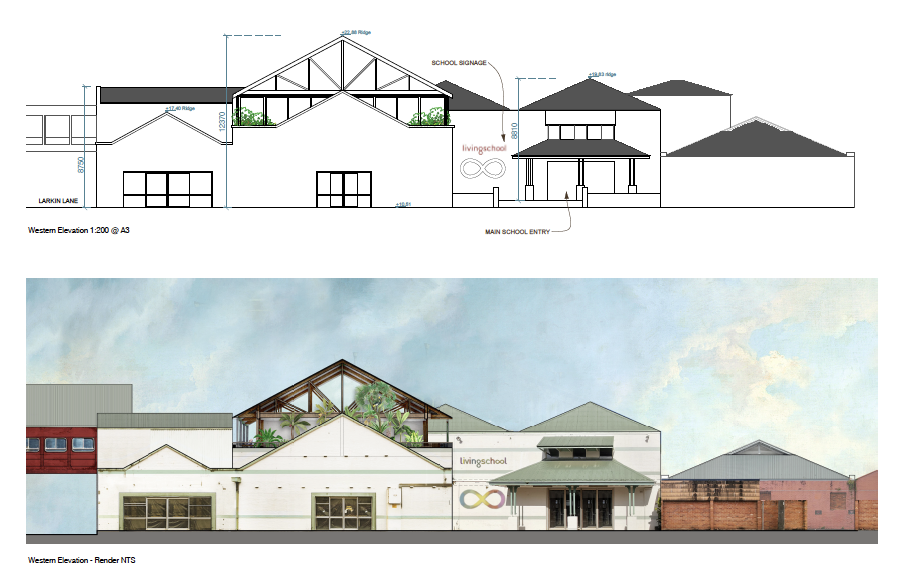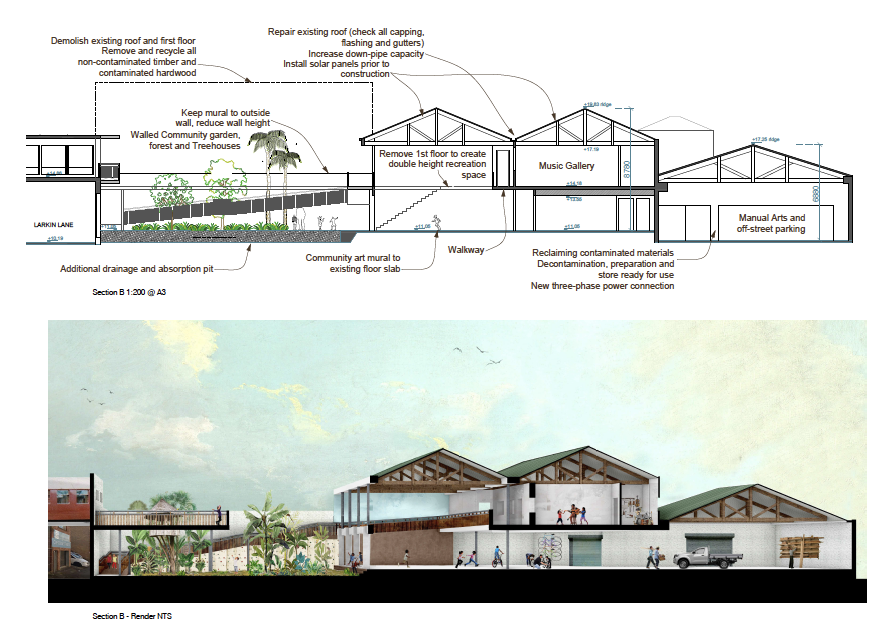John Stewart explains what the Living School will be in the CBD
Simon Mumford
15 September 2024, 8:00 PM

The Lismore App revealed John Stewart's plans for the Living School in November last year, which included the creative plans for the Brown & Jolly building on Woodlark Street.
John purchased the building in January 2021, but Covid and floods have delayed progress on delivering John's vision, as has the long DA process.
On September 5, the development application (DA) was submitted to council, revealing more plans for the two sites and, as you would expect, revealing some soil contamination and asbestos through the many reports that need to be accompanied as part of the DA.
Founder of the Living School, John Stewart, explained the DA process, his hopes of Stage 1 being complete by June next year and answered questions about public concerns about having a school on the CBD block
"Soil contamination was there, but that's all of Lismore, really. There wasn't much asbestos in that building because that building was a 1900 building."
"What takes longer is the flood. Then you've got all of the design requirements and plans and going through all the planning permissions and approvals. It's a process.
"I don't think people understand that to get a DA to where it's able to be submitted, you have to do a traffic report, you've got to do acoustics, you've got to do a building efficiency report, there are so many reports, traffic, flood management, mitigation. As a result of that, it's taking a lot longer than I had hoped."
In terms of time, the DA process has taken John two years.
"We were already looking at it before the flood. When the flood came through, council asked are you still going to be in the town? Because, as you know, most people were gun shy then and wanted to get out of the town. And that people feel you should not be building in the CBD.
"My view is that the buildings have always been in the CBD. We understand that floods come and go. I've been in floods in '74, but the reality is that we can mitigate against floods. And floods are going to come up, massive floods, so we know it'll be three days of water. Then you have to go and clean it out. You have to do the hygiene. The building, if we do it properly, will be able to mitigate against floods."
John feels that when we have another major flood after the school is open, it should take a week or two to reopen, depending on the severity of the flood.
"We don't want to put kids in a traumatic zone if there's a massive flood like '22. But, in 2022, we quickly moved and went down to the community hall at Lennox Head, and that was only three days later. And the reason we want to do that is because we want to make sure we support our parents and and our kids.
"If you're a parent and your house has been inundated and flooded, you don't want your kids around seeing you cleaning up and being in an emotional state, so we felt there was an obligation for us to get kids, give them fun, give them a sense of security, give them back to school and their mates, and then the parents can do their work."
As far as timing is concerned, John is hoping the DA will be approved within 90 days, so by the end of 2024.
"We've looked at everything that needs to be done, we've listened to what people have said, and we're aware of what we need to do to be a successful application. We've had pre-lodgement meetings. The intention of that school, moving into that space, is to allow Lismore to feel the success in the CBD.

"Part of why we want to do this is, is really not out of being stupid, but it's out of being supportive and giving people an understanding that a school could empower a town. We see it around the world. This isn't a model that's uniquely here. It is a model where schools are in department stores. There's High Tech High in California, which is through that space. There are schools in Finland, where they use warehouses.
"So, how do you use spaces that are available in there and create a repurposed venue for community? We're not trying to make an airport waiting lounge. We're trying to get kids into a building that's got history and heritage and give them that sense of connection with a town. Lismore CBD is unique because it is a CBD. It's a square within a square; it's blocks of streets. If you go down to some of our coastal towns, there is just the one street, and then they've built another street back from it. So it's not like an intentionally designed centre of a business district, which is what Lismore is."
Once the DA is approved, the build and fit-out will only take six months.
"We'll do it in stages," John explained, "So, the build is really repurposing a building, and the building's already there. We're looking at a six-month stage one. So, the intention would be that we would be in, all going to plan, by the middle of next year."
Stage 1 will be the building in the back lanes, Eggins and Larkin Lane where Spotlight used to be.

"In that building, we've already got big open spaces. So, it's just us putting on a new floor and moving a roof, taking a roof off. We want to have a walled garden with a rainforest in the heart of the town, and the reason we want to do that is intentional. It gives air to that building. It allows light into that building. It wraps itself within the Back Alley Gallery.
"There's a creative heart of Lismore. It also allows us to mitigate against floods. So if there's flood water that needs to be cleaned, and we all know that the first thing with a flood is you've got to get in quick and get that red mud out, so we can hose that into a rainforest space, and then we mulch it so it can be regenerated and the building can breathe. Because we also know one of the most toxic things within the flood was gyprock. We don't have gyprock. And secondly was black mould. Black mould grows where there's a lack of light and where it's moist. So we take that roof off, we'll get light flooding through.
"The materials at the bottom floor, we're not putting classrooms in that space, per se. We'll have learning spaces, but it's really concrete slab play areas. We'll have a half-court basketball court; we're going to have a yoga studio; we're going to have a pickleball court. So, the intentional play space, where people say, Where would they play? It's designed within the build."
With the lower levels being used for play space, flood preparation is a relatively easy task. Not only that, the Lismore CBD business community will benefit from the building's higher levels.
"We're also looking at how we support the business community during a flood. What we did last time in that flood was open our doors to all the cafes in the town because they're all having to move their fridges and white good stuff. So, we gave them the keys to the building and said just take them up and put them on the top floor. But nobody, as you know, expected the water to get into there.
"So, we are designing the building to have the capacity for the commercial cafes and shops to get access to our building in the case of a major, major flood. We want to be able to support them and move those white goods, so refrigerators and freezers, and then plug them into batteries. The other thing we know from the flood is that the electricity gets cut off, so we can get a battery bank run on solar, make sure it's floodproof, and then we want to be that community space that can support small business."
Stage 2 will be the Woodlark Street side, the Brown & Jolly building.
"In that space, we want to put in more learning areas. Have a shop front, the kids can run. We're going to change the escalator into a slippery slide. We want to do some really cool, funky things. We want to take that building back to its original state. When it was Spotlight and Better Electrical, it was all about covering everything in gyprock and putting shelves up, so you never got to see the original build.
"That original build as cast iron pillars. It's a 1900 building, so the roof heights are incredible. It's got pressed tin ceilings, and what had happened is they just gyprocked over it. It's got the most amazing colonial windows, that are all broken, but they're in the state; they were all just gyprocked in. So, we want people to see the heritage of Lismore, to feel a part of Lismore, and by looking at the past, you can also respect the future."

There has been a great deal of speculation and community concern about what having a school in the CBD will mean for Lismore. John answered some of those concerns.
"We're trying to create a community where students and children and parents are part of a connected space with public facilities and walking on footpaths. There's not a traffic drop-off spot in there. There'll be, of course, parking for teachers and spaces like that, but know that the kids will be dropped off at the Conway Street space or at the Transit Centre, and they have to walk into the site.
"The next phase of that is we'd love kids to be riding to school, so having bike stations where the kids can get their bikes and ride with their friends and get into school through the CBD. Now, why would you want to do that? Because kids have to be in space with the place, knowing shop owners, walking through streets, so people get to familiarise themselves.
"We don't want this idea of you get as close as you can, you open the door, and the kid jumps out. Why would you do that? Historically, and in my experience, where we used to have schools in the centre of London, and it was all about walking through that space. And when you walk with kids, you talk with kids. And so instead of us trying to get things and rush and hurry and drop, we want to slow it down. We want kids to be part of the public arena, and those people who've had shops in that space, when they see our little kids walk into the public library, when they see our kids going walking through the town to parks or to the community gardens. That's the idea of what we're doing."
Another community question has been around construction delays in the CBD.
"There will be minimal interruptions because where the car park space is, that's where the build will be. And the intention is we're taking the roof off. We can't go in and disturb the community, as it's operating as a CBD. So, part of this process is to take a roof off, and put a roof back on. That whole little car park space there is the facility of where you act from.
"I think people have to understand that we're not putting huge flaws on, and we're not we're not reshaping the building. What we're doing is repurposing and keeping loyal to that building's original look and actually, in part of it, improving it.
Hopefully, that gives the community a better understanding of what the Living School will be in the CBD come July 2025.

